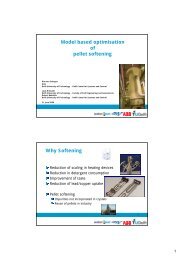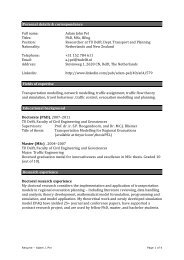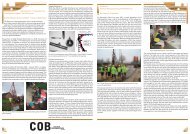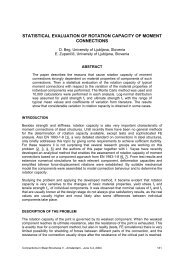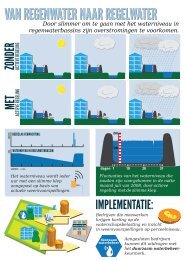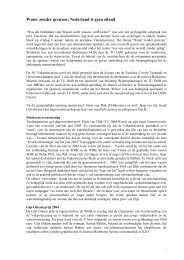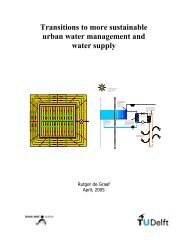Structural Design of Pavements PART VI Structural ... - TU Delft
Structural Design of Pavements PART VI Structural ... - TU Delft
Structural Design of Pavements PART VI Structural ... - TU Delft
Create successful ePaper yourself
Turn your PDF publications into a flip-book with our unique Google optimized e-Paper software.
45<br />
The remaining life ratio equals:<br />
1 – n/N = 0.36<br />
Assume that another 500000 standard axles should be carried by the pavement. This means<br />
that:<br />
∆n = 500000<br />
The tensile strain at the bottom <strong>of</strong> the asphalt layer should be decreased to a level where N +<br />
∆N load repetitions can be taken. This value is calculated from:<br />
N + ∆N = ∆n / (1 – n/N) = 500000 / 0.36 = 1.39 . 10 6<br />
By using the fatigue relation we calculate that this new number <strong>of</strong> allowable load repetitions<br />
can be obtained if the strain is reduced to ε = 1.48 . 10 -4 [m / m]. This means that the overlay<br />
needs such a thickness that the strain at the bottom <strong>of</strong> the existing asphalt layer is reduced to<br />
this value.<br />
The approach described here gives rise to some comments. It is quite clear that a very large<br />
overlay thickness is needed when the ratio n/N approaches 1. The reason is that the fatigue<br />
relation is based on beam fatigue tests. This implies that failure means that the specimen is in<br />
two parts if the allowable number <strong>of</strong> load repetitions is reached (at least in load controlled<br />
fatigue tests) which implies that the beam lost its functionality. In reality however the cracked<br />
asphalt slab is still supported by the base and other layers; the cracked slab is still functional.<br />
All this indicates that the procedure results in unrealistic designs in case <strong>of</strong> high values <strong>of</strong> the<br />
damage ratio.<br />
Furthermore the example indicates that in general fairly small strain reductions are needed<br />
which results in rather thin overlays.<br />
Because the overlay design is only based on the reduction <strong>of</strong> the strain level in the existing<br />
pavement, only the thickness and the stiffness <strong>of</strong> the overlay are <strong>of</strong> importance. From practice<br />
one knows that this cannot be true. The existing pavement normally exhibits a certain amount<br />
<strong>of</strong> cracking when an overlay is applied and these cracks tend to propagate through the<br />
overlay. This means that reduction <strong>of</strong> the strain level in the existing pavement cannot be the<br />
only design criterion for overlays; also the resistance to crack reflection <strong>of</strong> the overlay should<br />
be considered. This aspect will be discussed later in these lecture notes.<br />
Finally the procedure described above doesn’t take into account the large amount <strong>of</strong> variation<br />
in deflections and material characteristics that can occur in pavements.<br />
9.2 Extension <strong>of</strong> the basic principles:<br />
In this section an extension <strong>of</strong> the basic principles presented in the previous section will be<br />
given. The extension is dealing with the fact that in case the n/N ratio reaches 1, realistic<br />
values for the overlay thickness should still be obtained. Furthermore the extension takes into<br />
account the variation in deflection level and material characteristics that occur in practice.<br />
If there was no variation in deflection level along the section under consideration, and if there<br />
was no variation in the thickness <strong>of</strong> the pavement layers, then there would be no variation in<br />
the elastic modulus <strong>of</strong> the layers and there would be no variation in strain level. If there also<br />
would be no variation in the fatigue characteristics, then the pavement would fail precisely at<br />
the number <strong>of</strong> load repetitions predicted and the pavement would fail from one moment to the<br />
other. This particular behaviour is illustrated in figure 28a. Such a performance however is<br />
never observed, pavements don’t collapse in the way indicated by this figure. In reality a more<br />
gradual deterioration is observed as is indicated by figure 28b.<br />
If we use the mean strain level <strong>of</strong> figure 28b as design criterion and we use this strain value<br />
together with the mean fatigue characteristic (the solid fatigue line in figure 28b) then we<br />
determine the mean number <strong>of</strong> load repetitions. At that number <strong>of</strong> load repetitions there is a<br />
50% chance that the pavement is failed. It can easily be shown that this means that 50% <strong>of</strong><br />
the trafficked pavement surface shows cracking. Because <strong>of</strong> the variation in the fatigue



